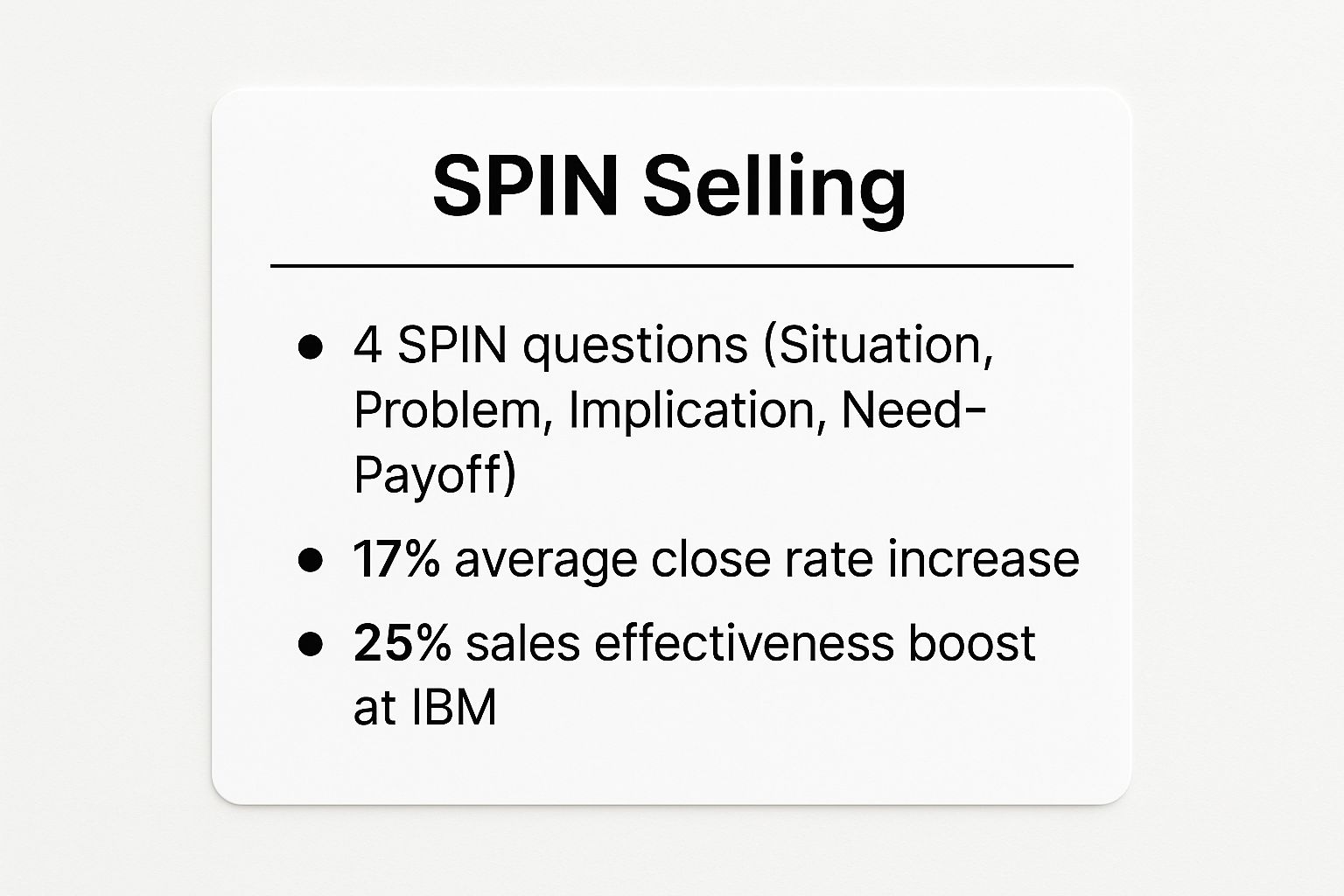In today's hyper-competitive B2B landscape, incremental gains are no longer enough. True sales performance improvement requires a fundamental shift, moving from simply selling products to orchestrating value-driven conversations across multiple channels. The old playbook of generic outreach and brute-force prospecting is obsolete. Buyers are more informed, more discerning, and more resistant to traditional sales tactics than ever before. This environment demands a more sophisticated approach, one that aligns with modern buyer behavior and leverages technology to create personalized, impactful interactions.
This article moves beyond surface-level tips to provide a deep dive into eight powerful, battle-tested sales methodologies. We'll explore how to leverage multichannel outreach and intelligent automation to implement these strategies effectively, turning abstract concepts into a concrete framework for sustainable growth. The principles discussed here extend beyond direct sales conversations; understanding related concepts like e-commerce conversion optimization can provide valuable insights into buyer psychology and digital engagement, further enhancing your overall sales performance.
Whether you're a solo professional, a growing team, or an established enterprise, this guide offers actionable blueprints for modernizing your sales process. You will learn to implement frameworks like the Challenger Sale, Account-Based Selling, and the Sandler System, equipping you with the tools necessary to build stronger relationships and close more deals. Mastering these approaches will be critical to not just hitting, but decisively exceeding your targets.
1. SPIN Selling
A cornerstone of consultative selling, SPIN Selling is a powerful methodology for sales performance improvement, especially in complex B2B sales cycles. Developed by Neil Rackham and Huthwaite International after analyzing over 35,000 sales calls, this framework shifts the focus from pitching a product to guiding a prospect through a process of self-discovery. Instead of leading with a solution, a salesperson uses a structured questioning sequence to help the buyer identify and articulate their own challenges.
The "SPIN" acronym represents four distinct types of questions designed to logically advance the conversation:
- Situation: These questions gather context about the prospect's current business environment. (e.g., "What tools are you currently using for your lead generation?")
- Problem: Once the situation is understood, these questions uncover specific difficulties or dissatisfactions. (e.g., "Are you concerned about the quality of leads your current process generates?")
- Implication: These are the most critical questions, used to explore the consequences and ripple effects of the identified problems, creating a sense of urgency. (e.g., "How does that poor lead quality impact your team's sales quota and morale?")
- Need-payoff: Finally, these questions encourage the prospect to envision the value and benefit of a real solution, effectively having them state the case for your product themselves. (e.g., "If you could automate lead qualification, how much time would that save your top reps each week?")
This buyer-centric approach positions the salesperson as a trusted advisor rather than just a vendor, building deeper rapport and uncovering needs that the prospect may not have even been fully aware of.
Key SPIN Selling Data Points
The infographic below summarizes the core components and proven impact of implementing the SPIN methodology.

As the data shows, adopting this structured questioning model can yield significant, measurable improvements in sales outcomes, as demonstrated by pioneering companies like IBM.
How to Master SPIN Selling
For a deeper dive into the psychology behind the SPIN framework, this video provides an excellent overview.
Successfully implementing SPIN requires more than just memorizing the question types. It demands practice and active listening. Start by building a bank of potential questions for different buyer personas and sales scenarios. During calls, focus intently on the prospect's answers to find threads for your next Problem or Implication question. Record and review your own sales calls to identify areas where you could have dug deeper or transitioned more smoothly. This continuous refinement is key to transforming your approach from a simple pitch to a powerful, consultative dialogue.
2. Value-Based Selling
A potent strategy for sales performance improvement, Value-Based Selling shifts the conversation from product features and price to the tangible, quantifiable business outcomes a customer can expect. Instead of just selling a service, this methodology focuses on selling a result. It requires a deep dive into the customer's business model, operational challenges, and financial priorities to build an undeniable case for return on investment (ROI). This approach is particularly effective in competitive markets where differentiation on features alone is difficult.
Value-Based Selling frames the solution in the language of the customer's C-suite: profit growth, cost reduction, and risk mitigation. The core principle is to demonstrate how your offering directly contributes to their key business objectives. The sales professional acts less like a vendor and more like a financial consultant, proving the economic value of the proposed partnership. Companies like Salesforce have leveraged this to great effect, reportedly increasing average deal sizes by linking their CRM solutions directly to customer revenue goals.
This outcome-focused method builds immense credibility and allows you to command premium pricing. By anchoring the discussion to value, price becomes a secondary consideration, making it a powerful tool to escape the commoditization trap.
Key Value-Based Selling Concepts
The infographic below highlights the fundamental pillars of a value-driven sales approach and its impact on customer decision-making.
As the data illustrates, presenting a clear, compelling business case directly tied to financial metrics is a critical driver in modern B2B purchasing decisions.
How to Master Value-Based Selling
To see how to construct a powerful value proposition, this video from ValueSelling Associates provides actionable insights.
Mastering this approach means becoming fluent in your customer's business. Start by researching their annual reports, industry benchmarks, and key performance indicators (KPIs). Develop industry-specific value calculators that can project realistic savings or revenue gains. During discovery calls, ask questions that uncover financial pain points: "What is the cost of this inefficiency to the business on a quarterly basis?" Use this data to co-create a business case with your prospect, presenting value in the terms they use internally. This transforms the sale from a simple transaction into a strategic investment.
3. Challenger Sale
A disruptive and highly effective approach to sales performance improvement, the Challenger Sale model flips traditional relationship-building on its head. Based on extensive research by Matthew Dixon and Brent Adamson of CEB (now Gartner), this methodology argues that the most successful reps aren't just relationship builders; they are "Challengers" who win by teaching, tailoring, and taking control of the conversation. Instead of discovering a customer's known needs, a Challenger introduces them to a problem or opportunity they didn't even know they had.
This model is built on a three-part framework:
- Teach: Challengers provide unique, commercial insights that reframe the customer's perspective on their own business. They don't sell features; they teach customers something new and valuable about their industry or market, leading them to a moment of realization.
- Tailor: The insights are not generic. They are meticulously tailored to the specific context, priorities, and economic drivers of the customer's organization and the individual stakeholder they are speaking with. This demonstrates a deep understanding of their world.
- Take Control: Challengers are assertive (not aggressive) and comfortable creating constructive tension. They guide the customer through the sales process, confidently pushing back on assumptions and focusing the conversation on value and business outcomes rather than price.
By challenging a customer's existing worldview with compelling insights, this approach creates urgency and differentiates the seller from the competition. Companies like Salesforce and ADP have successfully adopted the Challenger methodology to navigate complex sales environments and drive significant growth.
Key Challenger Sale Data Points
The graphic below highlights the core tenets of the Challenger Sale and the disproportionate success of this sales profile, especially in high-complexity sales.

As the research shows, the Challenger profile significantly outperforms other sales profiles, making it a powerful strategy for teams aiming to move beyond commodity selling.
How to Master the Challenger Sale
This short video from Gartner provides a concise summary of what it means to be a Challenger.
Becoming a true Challenger requires a significant shift from product-focused pitching to insight-led teaching. Start by deeply researching your target industries to develop unique commercial insights, not just rehashing common knowledge. Practice delivering these insights with conviction, using data and research to back up your claims. The goal is to build a coalition of support within the customer's organization by showing different stakeholders how your tailored solution solves their specific business challenges. This focus on business outcomes is the key to taking control of the sale and driving it to a successful conclusion.
4. Account-Based Selling (ABS)
A hyper-focused strategy for sales performance improvement, Account-Based Selling (ABS) inverts the traditional sales funnel. Instead of casting a wide net to capture as many leads as possible, ABS identifies specific, high-value accounts first and then engages them with highly personalized, coordinated outreach. This methodology treats individual target accounts as "markets of one," demanding deep research and bespoke messaging to penetrate and build relationships within key organizations.
Pioneered by thought leaders at Demandbase and popularized by Sangram Vajre, this approach aligns sales and marketing teams to work in concert. For example, Snowflake famously leveraged ABS to land massive Fortune 500 accounts, and Microsoft's enterprise division relies on it for its largest strategic clients. The core principle is quality over quantity, concentrating resources on the accounts most likely to generate significant revenue. This makes it an incredibly efficient model for B2B companies with complex products or long sales cycles.
ABS is not about a single salesperson making calls. It's a concerted effort across multiple channels and departments, orchestrated to provide a seamless, relevant buying experience for the entire decision-making committee at a target company. You can find out more by reading this comprehensive guide to Account-Based Selling on salesloop.io.
How to Implement Account-Based Selling
Successfully deploying an ABS strategy requires a shift in mindset from lead generation to account penetration. It is a strategic, long-term play that demands patience and precision.
- Identify and Research: Begin by defining your Ideal Customer Profile (ICP) and identifying a select list of target accounts that fit it perfectly. Invest significant time in account mapping to understand the organizational structure, identify key stakeholders, and uncover potential challenges and goals.
- Personalize and Engage: Craft account-specific value propositions and messaging. Instead of generic outreach, your communication should reference the company's specific initiatives, pain points, or industry trends. Engage multiple stakeholders across different departments through a coordinated, multi-channel sequence.
- Coordinate Across Teams: Ensure tight alignment between your sales and marketing teams. Marketing can support ABS efforts with targeted advertising, account-specific content, and executive events, while sales executes the personalized outreach.
- Measure and Expand: Track engagement across the entire account, not just individual leads. Once you gain a foothold, focus on expanding your relationships within the organization to cross-sell, upsell, and turn the account into a long-term strategic partner.
5. Solution Selling
A foundational consultative methodology, Solution Selling is a framework for sales performance improvement that transforms salespeople from product pushers into trusted problem-solvers. Popularized by Michael Bosworth, this approach centers on diagnosing a prospect's specific business challenges, or "pain points," before prescribing a tailored solution. Instead of leading with product features, the salesperson acts as a consultant, deeply understanding the customer's world to craft a unique value proposition.
This diagnostic process is often structured around a "9 Block Vision Processing Model," which guides the salesperson in helping the prospect create a vision of a solved problem. The key is to connect the prospect's pain to your specific capabilities, creating a powerful link between their problem and your solution. This approach is highly effective in complex sales environments where off-the-shelf products are not a perfect fit.
The core principles of Solution Selling are:
- Diagnose Before You Prescribe: Never present a solution until you have thoroughly understood the customer's pain and its business impact.
- Focus on Business Outcomes: Frame your solution in terms of tangible results, such as increased revenue, reduced costs, or mitigated risk, rather than just product features.
- Co-create the Solution: Work collaboratively with the prospect to build the solution vision, ensuring their buy-in and ownership of the final decision.
- Align with Power: Identify and engage with the decision-makers who have the authority and budget to approve the project.
By focusing on the customer's needs and co-creating a vision for success, Solution Selling builds deep, long-lasting relationships. Companies like Salesforce and IBM's Global Services division have built their enterprise sales models around this customer-centric methodology, proving its effectiveness in large-scale, complex deals.
How to Master Solution Selling
To successfully implement Solution Selling, deep industry knowledge and sharp diagnostic skills are essential. Sales professionals must become experts not just in their own products, but in their customers' businesses and competitive landscapes.
Start by developing a set of powerful, open-ended questions designed to uncover latent pain points. Practice asking "why" multiple times to get to the root cause of a problem. When presenting your solution, always tie it back to the specific business outcomes discussed, using the prospect's own language. Building relationships with both technical users and business executives is critical, as you need to demonstrate value from multiple perspectives. This method requires patience and a genuine desire to solve problems, but the result is a more strategic and sustainable path to sales success.
6. Social Selling
Social Selling is a modern strategy that transforms how sales professionals connect with prospects, representing a significant shift towards relationship-based sales performance improvement. Instead of relying on cold calls and traditional outreach, this approach leverages social media platforms like LinkedIn and Twitter to find, connect with, and nurture sales prospects. The core idea is to build authentic relationships and establish credibility by providing value long before a sales pitch is ever made.
Pioneered by digital sales leaders like Koka Sexton and Jill Rowley, Social Selling focuses on integrating into the prospect's digital world. It involves:
- Researching: Using social platforms to understand a prospect's needs, challenges, and professional interests.
- Engaging: Interacting with their content through thoughtful comments, likes, and shares to build rapport.
- Sharing: Posting valuable industry content and insights to position yourself as a trusted thought leader.
- Connecting: Building a network of relevant contacts and identifying decision-makers within target accounts.
This methodology moves the salesperson from an interruptive role to that of a valued member of the prospect's professional network. By doing so, they are top-of-mind when a need arises, creating warmer and more qualified inbound opportunities.
Key Social Selling Data Points
The impact of adopting a social selling mindset is well-documented. For instance, LinkedIn reports that 78% of social sellers outsell peers who don’t use social media. Furthermore, IBM’s groundbreaking social selling program was credited with helping generate an additional $1 billion in revenue, showcasing its scalability and power at the enterprise level. These figures highlight a clear correlation between social engagement and sales success.
How to Master Social Selling
Mastering social selling requires consistency and a genuine desire to help, not just sell. A great starting point is to fully optimize your social media profiles, especially LinkedIn, to reflect your expertise and the value you provide to your clients. Think of your profile as a resource, not a resume.
To put this into practice, start by dedicating 15-20 minutes each day to social selling activities. Use social listening tools to monitor keywords related to your industry and identify conversations you can contribute to. When you engage, focus on adding value, asking insightful questions, or sharing relevant resources. The goal is to build social currency and trust over time. This patient, value-first approach is what ultimately leads to a stronger pipeline and improved conversion rates.
For a more comprehensive look at building a robust plan, you can learn more about actionable Social Selling strategies on salesloop.io.
7. Sandler Selling System
The Sandler Selling System is a transformative methodology that flips the traditional sales dynamic on its head, making it a powerful driver for sales performance improvement. Developed by David Sandler, this system emphasizes establishing mutual respect and an equal footing between the buyer and seller. Rather than focusing on aggressive persuasion and closing tactics, Sandler-trained professionals act as consultants who rigorously qualify prospects, focusing on identifying pain points and ensuring a mutual fit.
The core of the system is represented by the "Sandler Submarine," a seven-step process that guides the sales interaction. This approach prioritizes disqualifying poor-fit prospects early to conserve resources for genuine opportunities. Key stages include building rapport, establishing an "Upfront Contract" to set clear expectations for the meeting, and uncovering the prospect's "Pain." Only after fully understanding the business and personal impacts of a problem does the conversation move toward budget and decision-making processes.
This methodology forces a shift from a seller-centric pitch to a buyer-centric diagnostic process. It empowers salespeople to ask tough questions early and maintain control of the sales process, preventing them from falling into the trap of "unpaid consulting" or chasing deals that are unlikely to close.
Key Sandler Selling System Data Points
The graphic below highlights the core principles and widespread adoption that underscore the Sandler methodology's effectiveness.
With over 30,000 companies implementing its principles, from real estate giants like Century 21 to countless B2B software firms, the Sandler System has proven its value across diverse industries.
How to Master the Sandler Selling System
For a clear explanation of the core philosophy behind the Sandler Submarine, this video from Sandler Training offers a great starting point.
Mastering Sandler requires a significant mindset shift. The goal is not just to sell, but to determine if a sale should happen. Begin by practicing the art of the Upfront Contract in every interaction to establish clear, mutual expectations. Focus on uncovering not just surface-level problems but the deep-seated business and emotional pain driving the need for a change. Crucially, you must become comfortable with disqualifying leads and be willing to walk away from prospects who are not a good fit. This discipline ensures your time is spent on high-probability opportunities, dramatically improving efficiency and closing rates.
8. Inbound Selling
A modern methodology that aligns the sales process with the contemporary buyer's journey, Inbound Selling is a critical driver of sales performance improvement. Popularized by HubSpot founders Brian Halligan and Dharmesh Shah, this approach flips the traditional outbound model on its head. Instead of chasing prospects with cold calls and generic emails, inbound selling focuses on attracting qualified leads by providing helpful, relevant content and solutions at every stage of their decision-making process. It's about being a resource, not a disruption.
This strategy transforms sales into a system where interested buyers come to you. The methodology is built on a simple premise: today's buyers are empowered. They conduct their own research online long before they ever want to speak to a salesperson. Inbound Selling meets them where they are with valuable blog posts, ebooks, webinars, and social media content.
- Attract: Draw in the right prospects with valuable content and conversations that establish you as a trusted advisor.
- Engage: Present insights and solutions that align with their pain points and goals, building rapport and trust.
- Delight: Provide an outstanding experience for customers, empowering them to find success with their purchase and become brand advocates.
By personalizing the sales experience based on the buyer's context and needs, sales teams can build stronger relationships and close deals more effectively. Companies like HubSpot and Drift have built their entire business models around this philosophy, with Drift generating over 1,000 qualified leads monthly through its inbound strategies.
How to Implement Inbound Selling
Successfully adopting an inbound approach requires a tight alignment between sales and marketing and a commitment to providing genuine value.
- Create Buyer-Centric Content: Develop content that addresses the specific questions and challenges your ideal customers face at each stage of their journey, from initial awareness to final decision.
- Leverage Marketing Automation: Use automation platforms to nurture leads with personalized content sequences based on their behavior and engagement.
- Align Sales and Marketing: Establish clear Service Level Agreements (SLAs) and shared definitions for what constitutes a marketing-qualified lead (MQL) and a sales-qualified lead (SQL).
- Personalize Your Follow-Up: Use data on how a lead has interacted with your content to tailor your outreach, making it more relevant and impactful.
This strategic shift not only improves lead quality but also shortens the sales cycle, as prospects are already educated and interested when they engage with a sales representative. For more practical strategies on how to get started, you can explore detailed guides about improving your sales team's performance on salesloop.io.
Sales Methodologies Comparison Overview
| Sales Methodology | Implementation Complexity 🔄 | Resource Requirements ⚡ | Expected Outcomes 📊 | Ideal Use Cases 💡 | Key Advantages ⭐ |
|---|---|---|---|---|---|
| SPIN Selling | High – requires extensive training and practice | Moderate – skilled salesperson and time intensive | Increased close rates (17%), shorter sales cycles | Complex B2B sales with longer cycles | Builds trust, deepens relationships, differentiates |
| Value-Based Selling | High – deep industry & financial knowledge needed | High – research, financial analysis, decision-makers | Larger deal sizes (30%), reduced price sensitivity | High-value B2B sales with significant investments | Justifies premium pricing, strong business relationships |
| Challenger Sale | High – requires business acumen and insight delivery | Moderate – research & confident delivery required | Proven effectiveness in complex sales | Complex B2B with multiple stakeholders | Creates urgency, credibility, differentiates with insights |
| Account-Based Selling | Very High – intensive, coordinated multi-team effort | Very High – CRM, research, personalized content | Higher conversion, larger deals, shorter cycles | Enterprise B2B targeting high-value accounts | Better alignment, relationship depth, conversion rates |
| Solution Selling | High – deep product and industry expertise needed | Moderate to High – consultative engagement | Strong relationships, higher loyalty | Complex B2B requiring customized solutions | Reduces price competition, builds long-term loyalty |
| Social Selling | Moderate – ongoing content creation and engagement | Moderate – digital tools and time investment | Builds authentic relationships at scale | B2B across industries, especially tech & professional | Reduces cold call rejection, builds personal brand |
| Sandler Selling System | High – mindset shift and certification required | Moderate to High – training intensive | Eliminates unqualified leads, improves forecasting | B2B sales, especially service-based businesses | Qualifies prospects early, reduces objections |
| Inbound Selling | Moderate to High – content development and marketing alignment | Moderate – marketing and content creation skills | Higher quality leads, scalable lead generation | B2B and B2C with online presence & content marketing | Builds trust via value, lowers acquisition cost |
Putting It All Together: Your Blueprint for Sales Excellence
Navigating the landscape of modern sales can feel like assembling a complex puzzle. We've explored a powerful arsenal of methodologies, from the deep-diving questions of SPIN Selling to the targeted strikes of Account-Based Selling and the relationship-centric approach of Social Selling. Each framework offers a distinct path toward a common goal: significant and sustainable sales performance improvement. The journey to the top of the leaderboard isn’t about discovering a single secret trick; it's about architecting a robust, adaptable system that blends proven strategies with powerful technology.
The central theme weaving through the Challenger Sale, Value-Based Selling, and every other strategy we've discussed is a fundamental shift in focus. It's a move away from the traditional product-pushing monologue and toward a buyer-centric dialogue. True sales excellence today is defined by your ability to understand, challenge, and ultimately deliver undeniable value to your prospects. This requires empathy, strategic thinking, and a commitment to solving problems, not just selling products.
From Theory to Action: Activating Your Strategy
Merely understanding these concepts is the first step, but true transformation happens during implementation. This is where many teams falter, getting bogged down in manual processes that stifle the very strategies they aim to adopt. The key is to operationalize your chosen methodology with intelligent automation, turning theoretical knowledge into consistent, daily action.
Think of it this way: if a framework like the Sandler Selling System is your strategic blueprint, then a platform for multichannel outreach is the high-performance engine that brings it to life. It enables you to execute your plan with precision and at a scale that would be impossible to manage manually. This combination frees up your sales reps to do what they do best: building relationships, understanding pain points, and closing deals.
Your Immediate Next Steps for Sales Performance Improvement
To translate this article's insights into tangible results, you need a clear action plan. Don't try to implement everything at once. Instead, follow a structured approach to ensure your efforts lead to meaningful sales performance improvement.
-
Conduct a Strategic Audit: Begin by evaluating your current sales process against the methodologies discussed. Which one aligns most closely with your ideal customer profile, product complexity, and market position? Are you a natural fit for the consultative Solution Selling, or does the disruptive nature of the Challenger Sale better suit your industry? Be honest about your team's strengths and weaknesses.
-
Select and Commit: Choose one or two primary frameworks to master first. Trying to be a master of all eight at once will lead to confusion and diluted efforts. For instance, you might combine the principles of Account-Based Selling for targeting with the questioning techniques of SPIN Selling for discovery calls.
-
Integrate Technology: Identify the manual chokepoints in your current workflow. Where are you losing time? Automate repetitive tasks like initial outreach, follow-ups across different channels (email, LinkedIn), and lead nurturing. This is the critical step that bridges strategy and execution.
-
Establish Your Metrics: You cannot improve what you do not measure. Before launching your new strategy, define your key performance indicators (KPIs). To ensure your blueprint is actionable and yields measurable results, it's essential to understand how to build your success dashboard for tracking sales performance effectively. This will provide the crucial feedback loop needed to refine your approach over time.
By systematically applying these steps, you create a powerful, self-reinforcing cycle of improvement. Your chosen methodology provides the "what" and "why," while automation provides the "how," ensuring your team can execute flawlessly and consistently. This strategic synthesis is the definitive path to building a high-performing sales machine that not only meets quotas but shatters them.
Ready to put these strategies into action with powerful automation? Salesloop.io provides the tools to build, personalize, and scale your multichannel outreach campaigns, turning your blueprint for sales performance improvement into a reality. Start your journey toward sales excellence today at Salesloop.io.





